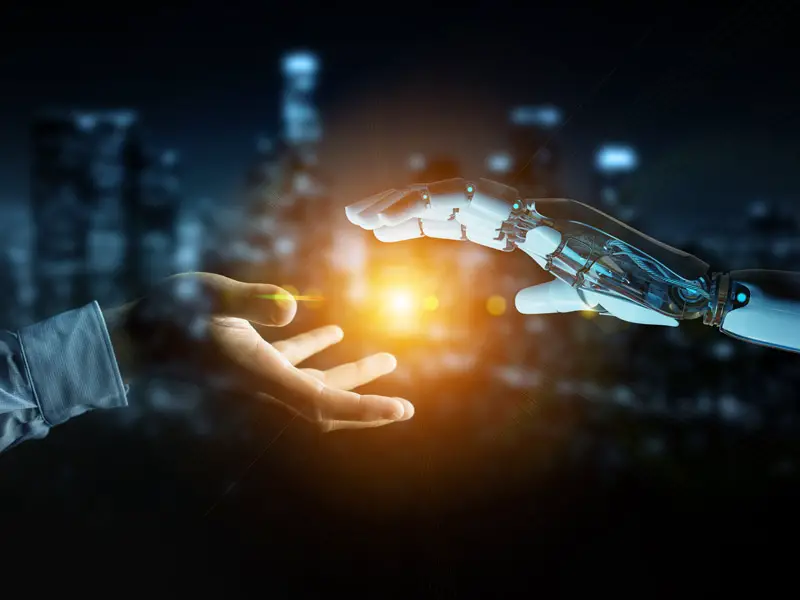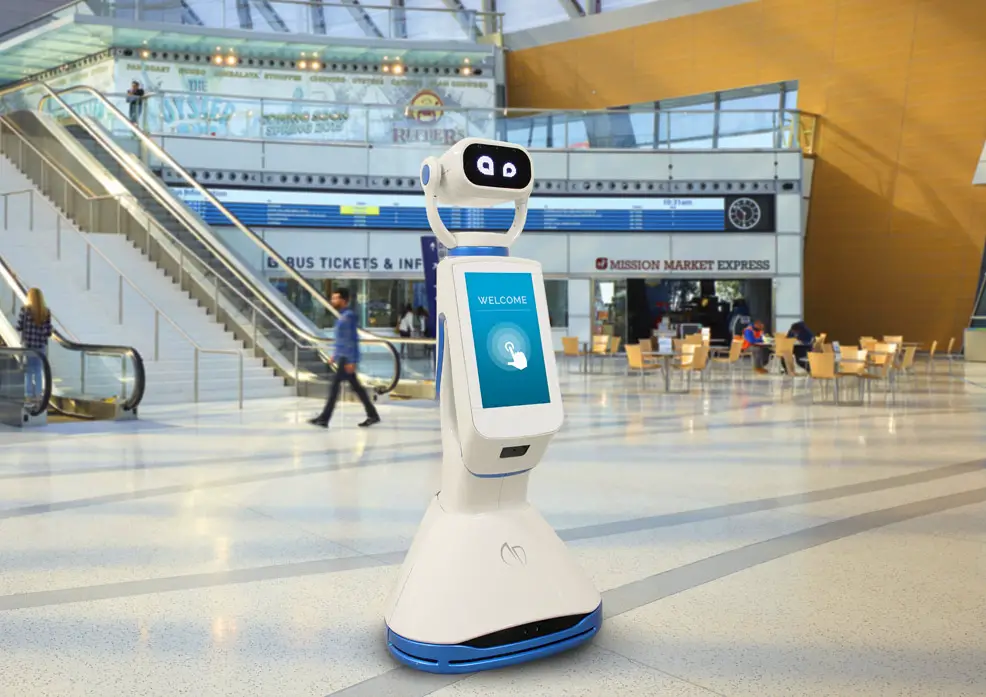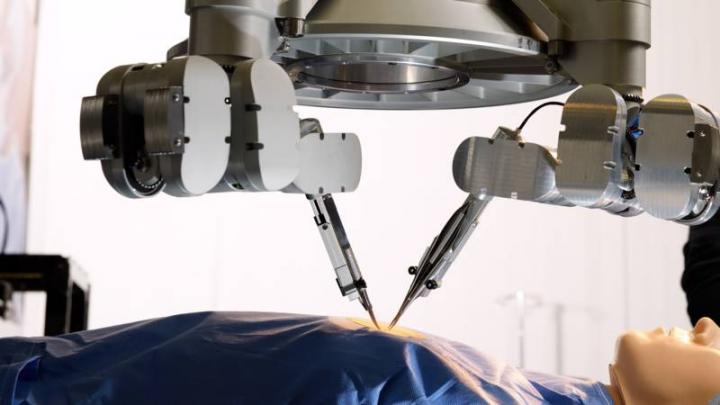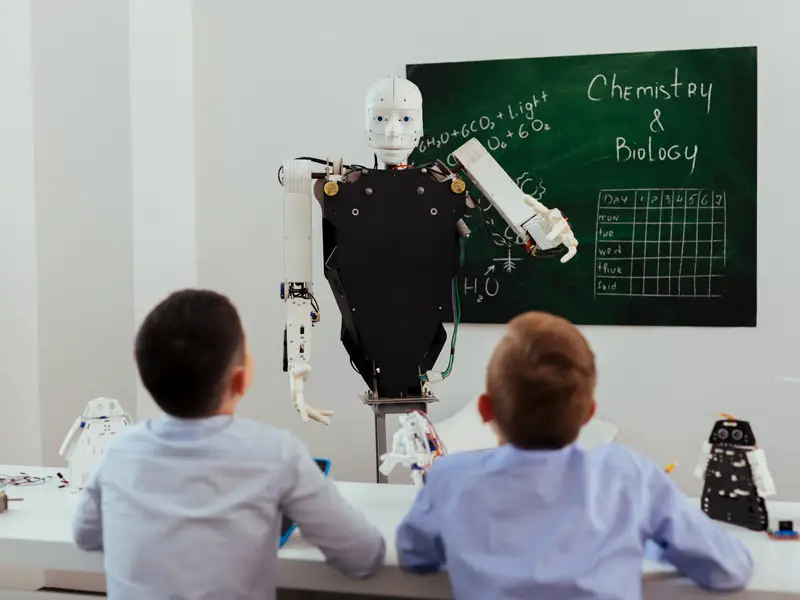
16th February 2019 The future of robots and artificial intelligence Robots and artificial intelligence (AI) bring exciting opportunities to industries, promising to make our future more automated and efficient. A guest piece by Richard van Hooijdonk
With advances in robotics and artificial intelligence continuing to surprise us, there probably is not a single industry being left untouched by these technologies. The robotics market, for instance, is growing faster than many of us would have expected. It is now projected to reach a value of $77 billion by 2022, more than double its size in 2017. AI is developing even faster. It grew from $700 billion in 2017 to $1.2 trillion in 2018 and is expected to be worth $3.2 trillion by 2022. Clearly, both robotics and AI are powerful markets, and the combination of these two technologies can change our lives for the better. Heasy, an interactive robot kiosk, is embedded with AI The retail industry is becoming increasingly automated, as it should be. Though some believe that robots are dangerous for our society and could gradually make humans obsolete, the reality is far less dramatic, at least in the retail world. Today, tech companies are developing smart robots suitable for a variety of services. One such innovation comes from the French robot manufacturer, Hease Robotics. The company's robotic solution, called Heasy, is a mobile kiosk that can be used in shopping centres, train stations, or airports. This autonomous robot is designed to greet, inform and guide customers. Thanks to its smart AI algorithms, the robot will navigate safely through crowded environments without bumping into people or objects. The machine is battery-powered and can operate for eight hours on a single charge. Besides serving as a welcome and information hub, Heasy can be used for other purposes. Since it features a big interactive screen, shops can use it to promote their products or allow consumers to take surveys. Compared to traditional kiosks, Heasy will generate 20 times more interactions. As the company's website reads, 85% of people who interacted with Heasy said they were satisfied with the service provided by the robot.
BrickBot learns how to assemble Lego structures Besides retail, the construction industry, too, is embracing intelligent automation. Despite being one of the largest sectors, construction has always been slow in adopting new technologies. But things are looking better for this industry as more innovations enter the market. Recently, the San Francisco-based firm AI Lab showcased its robotic solution, dubbed BrickBot. Unlike other machines that are programmed to do fixed, specific tasks, BrickBot is able to learn and act by itself. By understanding its environment, the robot can adapt and act accordingly. To make this achievable, the team at AI Lab harnessed the power of AI. While the development of BrickBot, which started in 2016, is still not fully completed, at a recent demonstration the company showed it is making progress. During the experiment, BrickBot used Legos to assemble a skyscraper model. Thanks to sensor data and machine learning, the robot was able to learn different shapes and sizes over time. Based on this acquired knowledge, BrickBot identified and picked only the Legos necessary to assemble the structure. Its developers are aware that putting this innovation into practical applications will take time, but they are confident it is feasible. Once this happens, industrial manufacturing and construction will never be the same.
AI-assisted surgery provides better precision The wave of innovation is set to transform healthcare as well. The applications for AI and robotics in this industry go beyond merely automating dull and repetitive administrative tasks. For instance, in 2017, the world witnessed the first super-microsurgery operation completed using robot hands. The surgery was not entirely performed by a robot, of course. Instead, the system developed by robotics company Microsure only assisted a human; but the operation, which was carried out on a patient with lymphoedema, proved to be a success. Lymphoedema is a condition in which extra fluid builds up under the skin, causing swelling. The only solution to this chronic condition lies in surgical treatment. However, this requires superb precision. Microsure's hi-tech system guarantees such control – enabling surgeons to use robotic hands to suture vessels as small as 0.3 millimetres (0.01 inches) in the arm of a patient. The system consists of two robotic arms, both controlled by a human surgeon. The surgeon's hand movement is "converted" into a more precise one and performed by the robot. Robotics Business Review reports that this technology is embedded with AI to reduce any tremors that might occur. The team at Microsure believes their innovation could be used on other, even more complex surgical interventions, such as tissue reconstruction. This will enable doctors to perform surgery with better precision and fewer complications.
Vector, the most adorable robot on the market The examples shown here so far prove that the age of human-robot coexistence has come, and this doesn't necessarily have to be a bad thing. There are many ways we can turn this to our advantage. Take home robots, for example. The U.S. robotics firm Anki has created a domestic robot called Vector to add fun to our daily routines. Vector is a small, autonomous companion equipped with a camera and embedded with machine learning tech. The robot won't vacuum your floors or take out the garbage. It will, however, serve as an adorable addition to your household. If you've always wanted to have a pet, but weren't allowed to own any, then Vector might be the right solution. As Vector moves through the home, it will create a 3D map of its surroundings and detect obstacles. Thanks to built-in facial recognition, it will recognise faces and respond in its own way. If you call the robot, Vector will activate and turn to you, carefully listening for further commands. Unlike similar products that are installed with Google Assistant or Alexa capabilities, Vector is embedded with its own voice assistant. You can simply ask for a weather forecast and the robot will respond in a split second. And in case you forgot to charge it, the robot will go to its charging dock by itself. The development team has even bigger plans for Vector. With further improvements to its software, Vector could detect if no one is at home, for example, and turn off the lighting to save energy.
The world got its first robot citizen There's no doubt that robots are great in assisting humans. While we still maintain our dominance, developments in humanoid AI robotics are making headlines. One robot in particular stands out. Her name is Sophia, and she's already achieved a lot. After receiving the citizenship of Saudi Arabia in 2017, Sophia became the world's first robot citizen. Not only that, but Sophia has also spoken with distinguished political figures and has attended conferences around the world. Developed by Hong Kong-based Hanson Robotics, this robotic solution can smile, laugh and express emotions, just like a human. Ask her a question and Sophia will give you the right answer; she may even tell a joke. This android uses cutting-edge machine learning to recognise faces and detect different hand gestures. Unlike other robots that look like they've come straight out of a sci-fi movie, Sophia is more realistic. Her design was inspired by the classic beauty of the actress Audrey Hepburn. Besides being beneficial for AI research, Sophia could be useful in industries such as education and medicine. For instance, she could offer companionship to the elderly at nursing facilities. In schools, robots like Sophia could assist teachers and provide one-on-one instruction to students. Following the success of Sophia, Hanson Robotics also developed Little Sophia. Despite being small in size, the robot is equipped with powerful AI. It can walk, learn, and serve as a smart assistant. To reach her fullest potential, she requires care and nurturing.
AI robots will soon teach English in Japanese schools As Hanson Robotics continues to make progress in AI robotics, many people are sceptical toward such innovations. But even though automation might displace some jobs, it could also solve the growing worker shortage. For the past few years, schools in Japan have been struggling to find qualified teachers, especially for English classes. This encouraged the Japanese government to develop a project that will be implemented this year. The project involves using AI robots to teach students English. If everything goes according to plan, the androids will be used in 500 schools across Japan. AI robots will help students to improve their listening, speaking, reading and writing skills. Such tech would be especially useful in remote areas where schools do not have enough language teachers, or lack funds to hire them. In conjunction with robots, schools will be using language apps and online lessons with native English speakers. Since Japan is forecast to experience an increase in tourism in the future, having an English-proficient population is a great plus. "As globalisation develops, it is assumed that communication skills in foreign languages will be required not only in businesses and careers, but in all kinds of situations over a lifetime," said Taichi Kaneshiro, from Japan's Ministry of Education.
Conclusion Both AI and robotics have come a long way. What seemed to be mere concepts just a few years ago are a reality today. Robots are becoming smarter, and while people still have mixed feelings about this technology, the truth is that we can't go back. Despite their alarming potential, the chances that we'll be wiped out by robots in the future are very slim. Instead of fearing these innovations, we should embrace them – after all, there isn't much we can do to prevent the ongoing advancement of technology.
Author: Richard van Hooijdonk International keynote speaker, trend watcher and futurist Richard van Hooijdonk offers inspiring lectures on how technology impacts the way we live, work and do business. Over 420,000 people have already attended his renowned inspiration sessions, in the Netherlands as well as abroad. He works together with RTL television and presents the weekly radio program 'Mindshift' on BNR news radio. Van Hooijdonk is also a guest lecturer at Nyenrode and Erasmus Universities.
Comments »
If you enjoyed this article, please consider sharing it:
|












